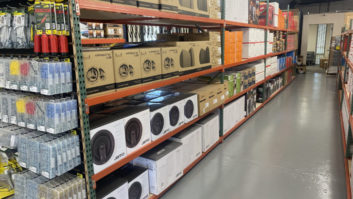New York – Worldwide
unit shipments of cellphones and smartphones broke records in the third
quarter, but their growth rates slipped from the year-ago quarter.
The reason for the
growth slippage was in part because consumers and carriers waited for Apple’s
next-generation iPhone and for BlackBerry handsets based on Research In Motion’s
(RIM) new OS 7, multiple research and consulting companies said.
Analysts from
Strategy Analytics, ABI Research and IDC also cited conservative consumer
spending during a period of economic volatility and falling Nokia smartphone
sales as the company transitions from the Symbian to Microsoft OSs.
Also during the
quarter Samsung took top spot in worldwide smartphone unit share, rocketing to
23.8 percent share from a year-ago 9.3 percent as Apple and Nokia shares fell,
Strategy Analytics found. (See table.)
In addition Apple’s
global smartphone growth rate slowed to 21 percent annually in the quarter to
its lowest level for two years, Strategy Analytics found.
Chinese maker ZTE
passed Apple to take the fourth-place spot in global share of all handsets,
with Apple slipping to fifth place despite Apple posting the third-highest
growth rate of any top-five vendor, ABI Research said. (See table.)
And overall
handset shipments declined in the United States and Western Europe in the third
quarter on a year-over-year basis, said IDC, which didn’t disclose U.S. smartphone
shipments.
Worldwide, although
overall handset-shipment growth slowed slightly in the third quarter, it wasn’t
by much, said Strategy Analytics director Neil Mawston. In smartphones, after
eliminating the effects of Nokia’s turmoil and people postponing a smartphone
purchase to wait for the new iPhone, smartphone growth wouldn’t have slowed at
all, he added.
“Global handset
shipment growth in the third quarter was a little slower than in the first half
of the year but nothing to set alarm bells ringing,” Mawston told TWICE.
First-quarter shipments of all handsets were up 19 percent year over year, and
the second quarter was up 12 percent for a first-half gain of 16 percent, he
said, while the third-quarter gain was 14.2 percent to 390 million units. (See table.)
The 14.2 percent
rate was down slightly from the year-ago gain of 15.2 percent.
The growth rate in
smartphone shipments, on the other hand, “dropped sharply,” Mawston said.
Smartphone shipments in the first quarter were up 86 percent and up 75 percent
in the second quarter for a first-half gain of 80 percent year over year while
third-quarter shipments were up 44.4 percent to 117 million. The third-quarter
growth rate was down significantly from the year-ago growth rate of 86.5
percent. Though growth slowed, the quarter’s shipments nonetheless hit a record
high, Strategy Analytics said.
“While overall
smartphone growth slowed, it was mostly due to Apple’s pause ahead of the
iPhone 4S launch and Nokia’s tough transition period from Symbian to
Microsoft,” he explained. “If we strip out Apple and Nokia from the figures,
the rest of the global market was growing at 106 percent year over year.”
Here’s how
Strategy Analytics, IDC, and ABI analyzed the quarter’s growth and vendor
shares:
Strategy
Analytics: “Despite ongoing economic volatility, global handset shipments grew
a relatively healthy 14 percent annually to reach 390 million units in Q3
2011,” said senior analyst Alex Spektor. “ZTE was the star performer as it
captured 5 percent market share and overtook Apple to become the world’s fourth
largest handset vendor. ZTE’s growth is being driven by competitive pricing of
entry-level models for feature phones and Android smartphones.”
Second-ranked
Samsung “continued to grow and reached an all-time-high marketshare of 23
percent, fueled by robust shipments of its high-end Galaxy S2 superphone,”
added Mawston.
LG stayed in third
place, but its share fell to 5.4 percent on shipments that declined to 21.1
million from the year-ago 28.4 million. LG’s Optimus One line of affordable
smartphones “lost some market momentum,” Mawston said.
Apple’s share of
total handset sales grew to 17.1 percent from 14.1 percent, but the company slipped
into fifth place in unit share because of the delayed launch of the iPhone 4S,
he said.
In smartphones,
Samsung shipped 28 million smartphones and overtook Apple to become the world’s
largest smartphone vendor with 24 percent market share, Strategy Analytics
said. “Samsung’s rise has been driven by a blend of elegant hardware designs,
popular Android services, memorable sub-brands and extensive global
distribution,” said Spektor.
Apple’s global
smartphone growth rate slowed to 21 percent in the quarter to its lowest level
in two years, Mawston said. “After just one quarter in the top spot, Apple
slipped behind Samsung to second position and captured 15 percent share,” he
said. “We believe Apple’s growth during the third quarter was affected by
consumers and operators awaiting the launch of the new iPhone 4S in the fourth
quarter, volatile economic conditions in several key countries, and tougher
competition from Samsung’s popular Galaxy S2 model.”
ABI: Third-quarter
smartphone shipments grew 33 percent year-over-year to 109.7 million,
accounting for 28.8 percent of total handsets shipments of 381 million.
“Lackluster smartphone shipments from Apple, RIM and Nokia have temporarily
halted the hyper growth of the smartphone market in Q3,” said senior
analyst Mike Morgan.
Motorola grew both
handset and smartphone shipments in the third quarter, ABI said. Samsung’s
legal issues with Apple didn’t slow its shipment growth, enabling Samsung to
remain “comfortably” in second place with 20.8 percent market share, the
company added.
IDC: The worldwide
mobile phone market grew 12.8 percent to 393.7 million in the quarter as
smartphone growth declined in key mature markets, the company said. It was the
second-lowest growth rate for the overall mobile phone market over the past two
years, reflecting delayed smartphone purchases and conservative consumer spending
last quarter, IDC explained.
Nonetheless, the
12.8 percent gain exceed IDC’s forecast of 9.3 percent and was stronger than
the second quarter’s 9.8 percent gain, IDC said.
Economically
mature regions such as the United States and Western Europe were hardest hit,
with overall handset shipments declining on a year-over-year basis in those two
regions.
In Western Europe,
demand fell not only for feature phones but also for smartphones, IDC said.













